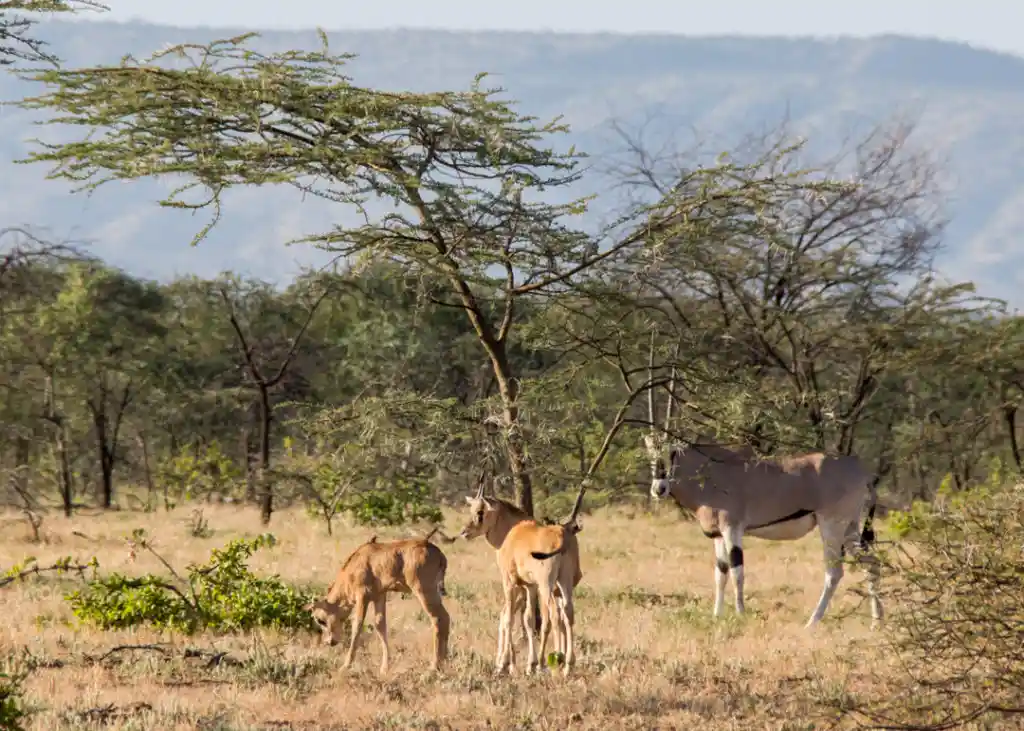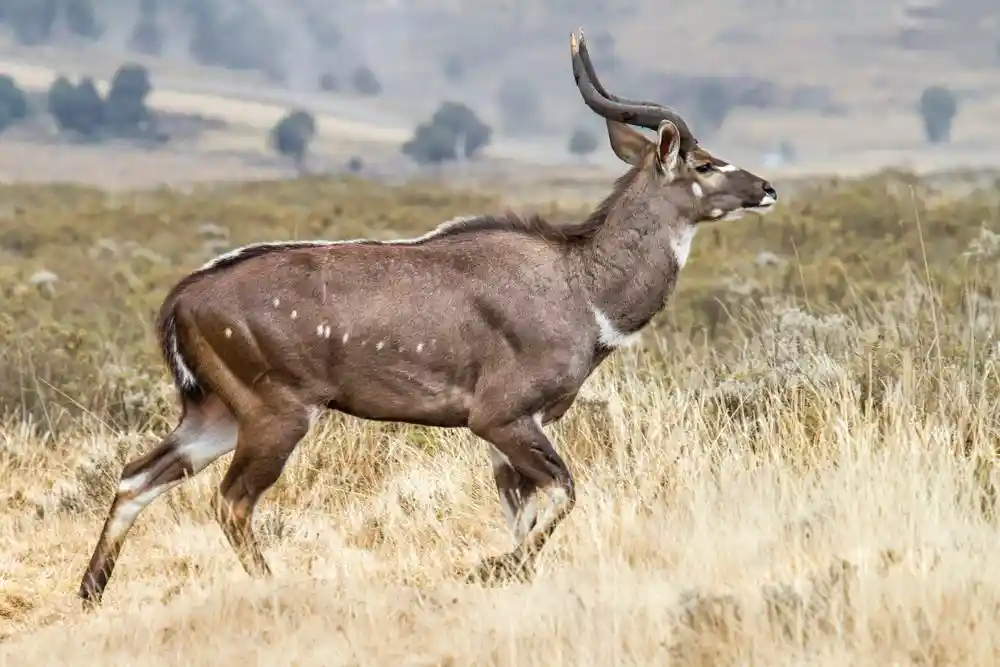National Parks

Awash National Park
Awash National Park is located 225 km east of Addis Ababa. It spans across the southern tip of the Afar(Danakil) Region and the south boundary of the park is formed by the Awash river.It covers an area of 827 square kilometers, most of the park lies at an altitude of 900m. The area is mainly acacia woodland and grassland. One of the main features is the Fantale volcano, on the southern flank of which can be seen the dark scar of the latest lava flow of 1820. In the south of the park the Awash River gorge has dramatic waterfalls. Another special attraction is beautiful hot springs in the north of the park. The water of these springs and rivers in the region is 36 degrees Celsius(97 degrees Fahrenheit) and is used by local people to water stock.
Awash National Park is rich in wildlife. It includes East African Oryx (Oryx beisa), the lesser and greater Kudus, Soemmerring’s Gazelle, Dik-dik , Warthogs Anubis baboons and Hamadryas baboons. The East African Oryx (Oryx beisa) lives many of the more open areas, and greater and lesser kudu the bushed areas. Soemmerring’s gazelle have distinctive white rumps and are frequently seen with the East African Oryx. The Dik-dik appears often under the dry acacia bushes. Moreover, there are over 350 species of native birds. The campsites are an excellent place for bird watching.
Senkelle Swayne’s Hartebeest Sanctuary
Senkelle Wldlife Sanctuary is located 48km west of Hawassa, it is 340 kms south of Addis Ababa and covers an area of 54km2. The sanctuary was originally established to protect the endemic and endangered antelope species called Swayne’s hartebeests. The sanctuary is located in between Oromia and SNNPRS and managed by the Ethiopian Wildlife Cconservation Authority. The open acacia woodland of the reserve is quite scenic and some of the animals are easily spotted, specially the Swayne’s hartebeests, the population of which is currently estimated at between 600 and 800. The sanctuary harbor other wild animals including Bohor, reedbucks, greater kudus, orbis antelopes, spotted hyenas, serval and civet cats, caracals, warthogs, common jackals as well as 91 species of bird.
Babile Elephant Sanctuary
The 698,200ha Babile Elephant Sanctuary is located 560km east of Addis Ababa and 25km south of the city of Harar. In part it encompasses a plateau, as well as the lowlands of the valleys of the Erer, Daketa, Fafen, Gobele and Borale Rivers; all being tributaries of the Shabelle River. Elevations range from 1000masl in the south to 1750masl in the north.
Large parts of the park’s lowlands have shrub and tree savannah, which is often very dense with both shrubs and cactus bushes. In the highlands, along the slopes of the ravines one often finds a very interesting dwarf Euphorbia, while the more commonly found Euphorbia trees grow native on the plateau of the reserve.
Other mammals living in the park are the Black-maned lion, Leopard, Cheetah, the Hamadryas Baboon, Papio hamadryas, Menelik’s bushbuck, Soemmerring’s Gazelle, and greater and lesser kudu. The bird list of 227 species includes the endemic Salvadori’s serine. Of the reptiles, noteworthy are enormous tortoises and other animals.
Babille is also home to the hot thermal springs, used to supply much of eastern Ethiopia with bottled mineral water. Just beyond the main entrance road into the park is the interesting geologic rock formations at Dakata’s Rock Valley with a wonderful balancing rock as well as lower hoodoos.

Bale Mountains National Park
The Bale Mountains National Park is located 400km southeast of Addis Ababa in Oromia National Regional State in South-eastern Ethiopia. It belongs to the Bale-Arsi massif, which forms the western section of the south-eastern Ethiopian highlands.The park covers the largest area higher than 3,000m above sea level in Africa. The highest peak in the BMNP, Tullu Dimtuu, at an altitude of 4,377masl, is the second highest peak in Ethiopia. It covers 2,200 square kilometers of these mountains. The park includes an Afroalpine plateau over 3,500masl, which is the largest area of Afroaplpine habitat on the African continent, as well as a major section of moist tropical forest, the second largest in Ethiopia.
It gives the visitor opportunities for unsurpassed mountain walking, horse riding, scenic driving and the chances to view various Ethiopia’s endemic mammals, in particular Menelik’s bushbuck, the famous mountain nyala, the Ethiopian wolf and Giant Mole rat and different endemic species of birds including Abyssinian Woodpecker, Crane, Rouget’s Rail, Abyssinian Cat Bird, White Backed Black Tit, Olive Trash and Wattle Ibis.
Yabelo Wildlife Sanctuary
Yabelo Wildlife Sanctuary is a protected area and wildlife sanctuary in southern Ethiopia. It is located in the Borena Zone of the Oromia Region west of the town of Yabelo, having an area of 2,500 square kilometers and elevations ranging from 1430 to 2000 meters above sea level.
The area of the Sanctuary is notable for its red soils which have little organic matter. The general vegetation-type is Acacia savanna, the major trees being A. drepanolobium on black cotton soil, and A. brevispica and A. horrida on the slopes. There are also patches of Balanites aegyptiaca, and several species of Commiphora and Terminalia at the lower altitudes. The higher parts of the hills were formerly covered with forest dominated by Juniperus procera and Olea europaea cuspidata. Endemic species of birds found in this protected area include Stresemann’s Bushcrow and White-tailed Swallow.
Yabelo reportedly suffers from a great deal of deforestation, and illegal hunting of the spotted cats and ostrich is common. Some ex-servicemen have also settled within the sanctuary boundaries.
Unique features – The Sanctuary affords protection to the endemic Swayne‟s Hartebeest and is the home of the endemic and vulnerable Ethiopian Bush Crow and White-tailed Swallow. The Ethiopian Bush Crow and White-tailed Swallow are also restricted-range species. Other non-endemic but globallythreatened species includes the Taita Falcon. With 62 Somali-Masai Biome birds, the site affords protection to 64% of Ethiopia‟s Somali-Masai Biome assemblage. Other interesting birds found here include Ostrich, Short-tailed Lark, Pringle‟s Puff-back, Northern Grey Tit, Abyssinian Grosbeak Canary, Vulturine Guinea fowl, Somali Sparrow, Black-capped SocialWeaver, Donaldson-Smith Nightjar, Star-spotted Nightjar, Grey-headed Social Weaver and Magpie Starling. The site is good for Burchell‟s Zebra and smaller numbers of Grant‟s Gazelle and Gerenuk.
MAGO NATIONAL PARK
Located about 782 kilometers south of Addis Ababa and on east bank of Omo river, the 2,162 square kilometers of this park are divided by the Mago River, a tributary of the Omo, into two parts. To the west is the Tama Wildlife Reserve, with the Tama river defining the boundary between the two. To the south is the Murle Controlled Hunting Area, distinguished by Lake Dipa which stretches along the left side of the lower Omo. The park office is 115 kilometers north of Omorate and 26 kilometers southwest of Jinka. The park has about 200km internal roads, which lead to the different attractions sites of the park. All roads to and from the park are unpaved.
Most easily accessed from the town of Jinka, Mago National Park is mainly savannah, with some forested areas around the rivers. It was set up to conserve the large numbers of plains animals in the area, particularly buffalo, giraffe, and elephant. Also seen here are topi and lelwel hartebeest, as well as lion, leopard, Burchell’s zebra, gerenuk, and greater and lesser kudu. The birds are also typical ofthe dry grassland habitat, featuring bustards, hornbills, weavers, and starlings. Kingfishers and her-ons feed in and around the Neri River, which provides an alternative habitat.
The major environments in and around the Mago Park are the rivers and riverine forest, the wetlands along the lower Mago and around Lake Dipa, the various grasslands on the more level areas, and scrub on the sides of the hills. Open grassland comprises about 9% of the park’s area. The largest trees are found in the riverine forest beside the Omo, Mago and Neri. Areas along the lower Omo (within the park) are populated with a rich diversity of ethnic groups, including the Aari, Banna, Bongoso, Hamer, Karo, Kwegu, Male and Mursi peoples. The park’s perhaps best known attraction are the Mursi, known for piercing their lips and inserting disks made of clay.
Gambella National Park
Gambella National park is located 850 km west of Addis Ababa. It was established as a protected area in 1973 to conserve a diverse assemblage of wildlife and unique habitats. Although not technically in the Rift Valley, Gambella National Park lies along another of the country’s important rivers: the Baro. Near the town of Gambella, Gambella National Park, is one of Ethiopia’s least developed parks and has no facilities. Nevertheless, the large conservation area contains many species not found elsewhere in the country, such as the Nile lechwe and the white-eared kob. Roan antelope, topi, elephant, buffalo, giraffe, and the unusual whale-headed stork are also to be found here.
Originally the park was created for protection of extensive swamp habitat and ts wildlife. Located on the Akobo river system, it hosts several wildlife not found elsewhere in Ethiopia. The banks of the baro are rich in birdlife and thus give visitors an extra advantage. With its total area of approximately 50,600 hectars, it is the largest protected area in the country. Its northern boundary is formed by the Baro River. To the south of the park isthe Gilo River flows from Gog to Tor in a northwesterly direction.
The landscape of Gambella is low and flat with altitude ranging from 400 to 768 masl. The average altitude is around 500 meters above sea level. The people of this area are the Anuak and the Nuer. Mainly fisherfolk – but also cattle herders – the Anuak and Nuer are extremely handsome, with dark, satiny complexions. Both men and women favour a style of decorative scarification on the chest, stomach, and face; and often boast heavy bone bangles, bright bead necklaces, and spikes of ivory or brass thrust through a hole pierced in the lower lip and protruding down over the chin. Unaffected by the ways of the modern world, these interesting people remain as remote, unchanged, and beautiful as the land in which they live.
